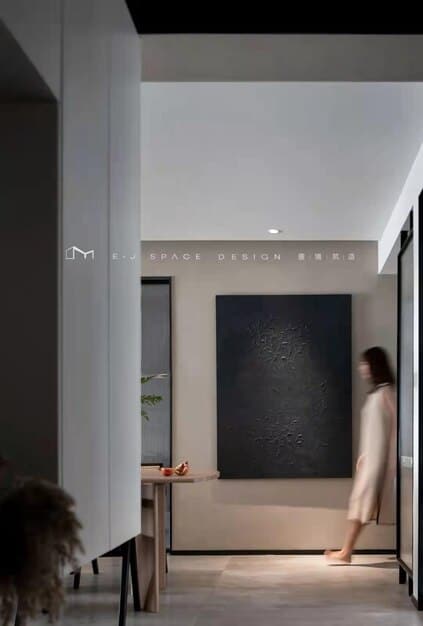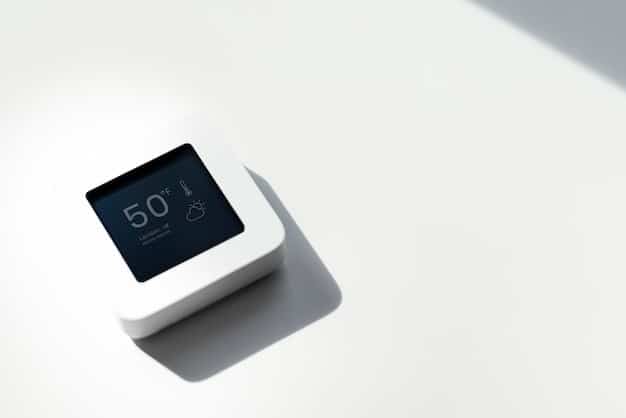6 Smart Home Devices to Transform Your Interior Design in 2025

Discover how six innovative smart home devices will revolutionize interior design in 2025, seamlessly blending technology with aesthetics to create sophisticated and functional living spaces.
Elevate your interior design with cutting-edge technology! This article explores 6 smart home devices that will elevate your interior design in 2025, seamlessly blending functionality with style to create a modern and sophisticated living space.
Transform Your Home with Smart Technology
The realm of interior design is constantly evolving, and in 2025, smart home technology will play an even more integral role in shaping our living spaces. These devices seamlessly integrate into our homes, offering both convenience and aesthetic appeal.
From enhancing ambiance to optimizing functionality, let’s explore how these innovations will become essential elements in modern interior design.
The Rise of Integrated Smart Homes
Smart home technology is no longer a futuristic fantasy. It’s a present-day reality that enhances how we live and interact with our homes. In 2025, integration will be key.
Expect seamless connectivity between devices, intuitive interfaces, and personalized experiences that cater to individual lifestyles.
- Enhanced Convenience: Automate daily tasks, such as lighting and temperature control, to simplify your life.
- Increased Energy Efficiency: Smart thermostats and lighting systems optimize energy consumption, reducing utility bills.
- Improved Security: Smart security systems provide peace of mind with features like remote monitoring and intrusion detection.
- Personalized Experiences: Tailor your home environment to your preferences with customizable settings and routines.

In conclusion, smart technology is poised to transform our homes by making them more convenient, efficient, secure, and personalized. As we look to 2025, these devices will be fundamental components of interior design.
1. Smart Lighting: Setting the Perfect Mood
Smart lighting solutions extend far beyond simple on/off switches. Advanced systems offer customizable color palettes, dimming capabilities, and automated schedules, allowing you to create the perfect ambiance for any occasion.
Imagine transforming your living room from a bright, energizing space during the day to a cozy, relaxing retreat in the evening – all with a few taps on your smartphone.
Dynamic Color and Dimming
The ability to adjust the color and intensity of lighting is a game-changer for interior design. Create warm, inviting atmospheres or cool, energizing environments with ease.
Smart lighting systems also allow you to fine-tune the brightness levels, reducing glare and enhancing visual comfort.
Automated Schedules and Scenes
Smart lighting can be programmed to automatically adjust based on the time of day or specific events. Set the lights to dim gradually as the sun sets or create custom scenes for movie nights or dinner parties.
This level of automation not only adds convenience but also enhances the overall aesthetic appeal of your home.
- Wake-Up Lights: Simulate a natural sunrise to gently wake you up in the morning.
- Security Lighting: Deter intruders by automatically turning on lights when you’re away from home.
- Mood Lighting: Create custom lighting scenes for different activities, such as reading, working, or relaxing.
Ultimately, smart lighting transforms your home by controlling ambiance, enhancing convenience, and offering infinite customizability. As we move closer to 2025, these solutions will become essential for every home.
2. Smart Mirrors: A Window to Information
Forget traditional mirrors – smart mirrors are revolutionizing the way we interact with our reflections. These innovative devices integrate displays, cameras, and voice assistants, providing real-time information and interactive experiences.
Check the weather, browse social media, or even video call a friend, all while getting ready for the day.
Integrated Displays and Cameras
Smart mirrors feature built-in displays that can show everything from the time and date to news headlines and social media feeds. Some models also include cameras for taking selfies or making video calls.
High-resolution displays ensure clarity and sharpness, while discreet camera placement maintains privacy.
Voice Assistant Integration
Control your smart mirror with your voice using integrated voice assistants like Amazon Alexa or Google Assistant. Ask questions, set reminders, or even control other smart home devices without lifting a finger.
Voice control adds convenience and enhances the hands-free experience.

- Fitness Tracking: Monitor your heart rate and other fitness metrics while working out.
- Virtual Makeup Tutorials: Try on different makeup looks and learn new techniques with interactive tutorials.
- Personalized Recommendations: Receive tailored styling tips and product recommendations based on your preferences.
In conclusion, smart mirrors are a big step up from traditional mirrors, because they provide real-time information and interactive experiences. As we move toward 2025, these devices will play a larger role in every modern home.
3. Advanced Climate Control: Personalized Comfort
Achieving the perfect temperature and humidity levels in your home is now easier than ever with advanced climate control systems. These devices use sensors and algorithms to monitor and adjust the environment, ensuring optimal comfort and energy efficiency.
Say goodbye to temperature fluctuations and hello to a consistently comfortable living space.
Smart Thermostats and Sensors
Smart thermostats learn your preferences and adjust the temperature accordingly, saving energy and reducing utility bills. Sensors placed throughout your home monitor temperature and humidity levels, providing real-time feedback to the system.
Geofencing capabilities allow the system to automatically adjust the temperature when you leave or approach your home.
Zoned Heating and Cooling
Zoned heating and cooling systems allow you to control the temperature in different areas of your home independently. This is particularly useful for larger homes or those with multiple occupants who have different preferences.
Set different temperatures for bedrooms, living rooms, and offices to maximize comfort and energy efficiency.
- Air Quality Monitoring: Detect pollutants and allergens in the air and automatically activate air purifiers.
- Remote Control: Adjust the temperature and humidity from anywhere using your smartphone app.
- Energy Savings: Reduce energy consumption by optimizing heating and cooling schedules.
Overall, advanced climate control systems ensure greater customization, personalization, and cost effectiveness for any home in 2025.
4. Smart Blinds and Shades: Automated Privacy and Light Control
Control the amount of natural light and privacy in your home with smart blinds and shades. These automated window coverings can be programmed to open and close based on the time of day, weather conditions, or your personal preferences.
Enjoy the benefits of natural light without sacrificing privacy or energy efficiency.
Automated Schedules and Sensors
Smart blinds and shades can be programmed to automatically open at sunrise and close at sunset, maximizing natural light and reducing the need for artificial lighting. Sensors can detect sunlight and adjust the blinds accordingly, preventing glare and overheating.
Integrate with your smart home system to control the blinds with your voice or smartphone app.
Remote Control and Customization
Adjust the blinds from anywhere using your smartphone app. Create custom scenes for different activities, such as movie nights or afternoon naps. Set the blinds to automatically close when you leave home for added security.
Choose from a variety of materials and styles to complement your interior design.
- Blackout Shades: Create a dark and peaceful environment for sleeping.
- Privacy Shades: Maintain privacy while still allowing natural light to enter.
- Energy-Efficient Shades: Reduce heat gain in the summer and heat loss in the winter.
Smart blinds can be adjusted based on factors like the time of day, weather, and personal preference, resulting in more convenience and customization.
5. Smart Furniture: Multifunctional and Space-Saving Designs
As living spaces become smaller and more expensive, smart furniture is gaining popularity as a way to maximize functionality and save space. These innovative pieces incorporate technology and clever design features to adapt to your needs.
Transform your living room into a home office or your bedroom into a guest room with ease.
Transforming Tables and Seating
Transforming tables can be adjusted to different heights and configurations, serving as coffee tables, dining tables, or desks. Seating can be folded away or converted into beds, providing flexible sleeping arrangements for guests.
These versatile pieces are perfect for small apartments or multi-purpose rooms.
Storage Solutions
Smart furniture also maximizes storage space with hidden compartments, drawers, and shelves. Lift-top coffee tables provide storage for blankets, pillows, and remote controls. Ottomans with built-in storage offer a convenient place to stash books, magazines, and toys.
Keep your living space clutter-free with these clever storage solutions.
- Charging Stations: Charge your phone, tablet, and other devices with built-in charging stations.
- Integrated Lighting: Enjoy ambient lighting with integrated LED strips and lamps.
- Adjustable Comfort: Customize the firmness and support of your mattress with adjustable air chambers.
When living spaces are more personalized and organized, comfort and usefulness are improved. As a result, comfort and usefulness are elevated. In 2025, living spaces will benefit greatly from smart furniture.
6. Voice Assistants: The Central Hub
Voice assistants like Amazon Alexa, Google Assistant, and Apple Siri have become the central hub for controlling smart home devices. These AI-powered assistants allow you to manage your home with simple voice commands.
Turn on the lights, adjust the thermostat, play music, or even lock the doors – all without lifting a finger.
Seamless Integration
Voice assistants seamlessly integrate with a wide range of smart home devices, allowing you to control them from a single platform. Create custom routines that automate multiple tasks with a single command. For example, say “Goodnight” to turn off the lights, lock the doors, and set the thermostat to a comfortable sleeping temperature.
The intuitive interface makes it easy to manage your smart home even if you’re not tech-savvy.
Personalized Experiences
Voice assistants learn your preferences and provide personalized recommendations based on your habits and interests. Get news updates, weather forecasts, and traffic reports tailored to your location. Set reminders, create shopping lists, and manage your calendar with voice commands.
Enjoy a more convenient and efficient lifestyle with voice assistant integration.
- Entertainment Control: Control your TV, speakers, and other entertainment devices with your voice.
- Home Security: Arm and disarm your security system, lock and unlock the doors, and view camera feeds with voice commands.
- Information Access: Get answers to your questions, set timers, and make phone calls with your voice.
To summarize, voice-activated command centers provide intuitive interfaces for convenient use that add personalization to any home. As a result, in 2025, they will have enhanced the homes of many.
| Key Feature | Brief Description |
|---|---|
| 💡 Smart Lighting | Adjust color and brightness via app for perfect ambiance. |
| 🪞 Smart Mirrors | Displays news, weather, and fitness tracking. |
| 🌡️ Climate Control | Smart thermostats optimize temps across rooms. |
| 🔊 Voice Assistants | Control devices, play music, and answer questions. |
FAQ
▼
Smart devices will encourage minimalist designs, hiding tech for sleek aesthetics. Expect integrated tech, blending seamlessly with decor.
▼
Smart lighting offers customizable ambiance, energy savings, and automation. Control lighting remotely, set schedules, and create custom scenes easily.
▼
Smart mirrors offer real-time info like weather, news, and fitness tracking. Virtual makeup tutorials and personalized styling tips add convenience.
▼
Consider space, functionality, and integration with your smart home system. Look for multifunctional pieces, storage solutions, and charging stations.
▼
Security varies; use strong passwords, two-factor authentication, and keep software updated. Buy reputable brands with robust security measures.
Conclusion
As we look toward 2025, it’s clear that smart home devices will play a significant role in interior design, combining functionality with aesthetics to create living spaces that are both beautiful and efficient. From smart lighting and mirrors to advanced climate control and voice assistants, these innovations offer endless possibilities for personalizing your home and enhancing your lifestyle.





